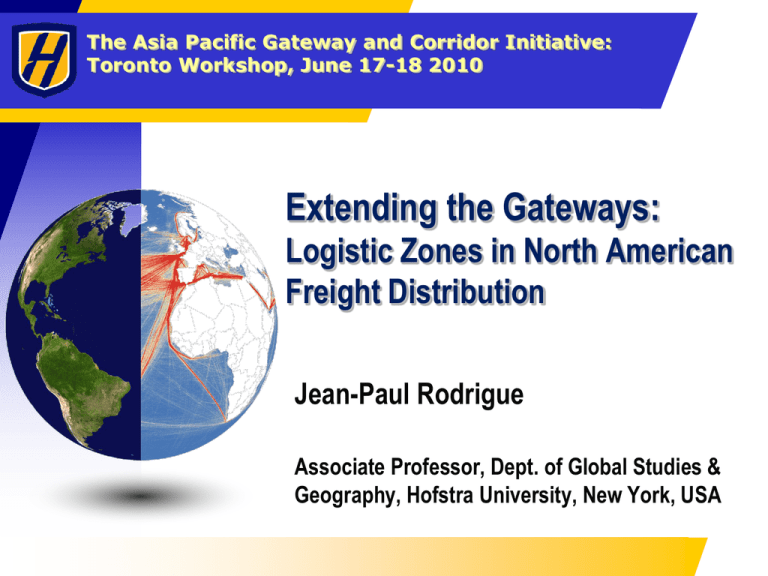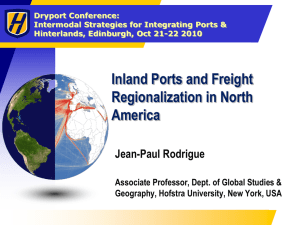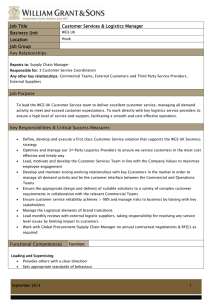Extending the Gateways: Logistic Zones in North American
advertisement

The Asia Pacific Gateway and Corridor Initiative: Toronto Workshop, June 17-18 2010 Extending the Gateways: Logistic Zones in North American Freight Distribution Jean-Paul Rodrigue Associate Professor, Dept. of Global Studies & Geography, Hofstra University, New York, USA What Drives Supply Chain Management? World’s Major Gateway Systems and Hinterland Structure, 2006 Inland concentration Coastal gateways 39 Gateway Regions 90% of the World’s Freight Transport Pearl River Delta: 16.7% Coastal concentration Landbridge connections Coastal concentration Low hinterland access Extending the Gateways: Two Dimensions Gateway / Port Regionalization (A) •Satellite terminals and logistics zones. •Maritime / land interface. Inland Port (B-C) •Corridor development. •Regional load centers. Gateway A B C On-dock and near dock Logistics Zone Logistics Zone Logistics Zone A Satellite terminal Corridor Logistics Zone B-C The Complexities of Inland Logistics: The “Last Mile” in Freight Distribution Massification Atomization Frequency Capacity HINTERLAND GLOBAL Shipping Network Corridor REGIONAL LOCAL Segment Inland Terminal Gateway Distribution Center On-dock and near dock A Satellite terminal “Last Mile” Logistics Zone Logistics Zone Logistics Zone Customer Corridor Logistics Zone B-C Extending the Gateway Through Governance Changes Conventional Port Authority • Planning and management of port area. • Provision of infrastructures. • Planning framework. • Enforcement of rules and regulations. • Cargo handling. • Nautical services (pilotage, towage, dredging). Expanded Port Authority The North-American Container Port System and its Multi-Port Gateway Regions 4 2 1 3 6 5 7 Multi-port gateway regions 1. San Pedro Bay 2. Northeastern Seaboard 3. Southwestern Seaboard 4. Puget Sound 5. Southern Florida 6. Gulf Coast 7. Pacific Mexican Coast Something Strange Happened on the Way to the Terminal… Transportation Freight Village Terminals Networks Roads / lines Rights of way 1 1 Outdoor Storage 2 Port terminals Rail terminals Airports Inventory at terminal Storage Energy 2 Warehousing Distribution centers Cross-docking Inventory in transit Containerization Growth Factors: Which Opportunities are Left? A Derived / Organic (A) Economic and income growth. Globalization (outsourcing and global sourcing). Fragmentation of production and consumption. Substitution (B) Functional and geographical diffusion. New niches (commodities and cold chain) Capture of bulk and break-bulk markets. Incidental (C) Trade imbalances. Repositioning of empty containers. Induced (D) Transshipment (hub, relay and interlining). B C D American Foreign Trade by Maritime Containers, 2008 (in TEUs): The Trade Fundamentals Importers Exporters Whirlpool JC Penney Nike Red Bull Samsung Jarden General Electric Ashley Furniture Ikea Heineken Chiquita Philips LG Group Lowe's Costco Wholsale Dole Food Sears Holding Home Depot Target Wal-Mart Newport Chinternational Sims Metal Management CGB Enterprises Denison JC Horizon ExxonMobil Delong BASF Archer Daniels Midland Cedarwood-Young Meadwestvaco Procter & Gamble Potential Industries Dupont Dow Chemical International Paper Koch Industries Cargill Weyerhaeuser America Chung Nam 0 200,000 400,000 600,000 800,000 0 200,000 400,000 600,000 800,000 Asymmetries between Import and Export Containerized Logistics Gateway Inland Terminal Distribution Customer Center Many Customers (Importers) •Function of population density. •Geographical spread. •Incites transloading. •High priority. Repositioning Supplier Few Suppliers (Exporters) •Function of resource density. •Geographical concentration. •Lower priority. •Depends on repositioning opportunities. Distribution Network Configurations for Containerized Import Cargo Type Supply Chain Gateway-based Few mass market goods (economies of scale in distribution). Few very specialized goods (economies of scale in warehousing). Little if any transformations. Transloading. Tiered-based Mix of retail goods coming through a few gateways. Some customization. Large suppliers and large retailers (Big Box). Transloading, Postponement and Cross-docking. Regional distribution centers Complex set of goods coming from numerous suppliers (e.g. automotive parts). Regional variation of the nature and extent of demand. Local distribution centers Time sensitive bulky cargo (e.g. perishables). Low lead times. City logistics. Distribution based on RDCs Distribution based on tiered system Distribution based on two gateways Distribution based on local DCs Optimal Location and Throughput by Number of Freight Distribution Centers Functional Relations between Inland Terminals and their Hinterland Freight Region Logistics Pole FLOWS & INTEGRATION Inland Terminal I II Logistics activities Retailing and manufacturing activities III Added Value Activities Performed at an Extended Gateway Activity Functions Consolidation / Deconsolidation Inventory management practices. Cargo consolidated (or deconsolidated) into container loads (paletization). Attaining a batch size (group of containers) fitting a barge or a train shipment. Breaking down batches so that they can be picked up by trucks. Transloading Change in to load unit (Maritime / Domestic). Consolidation, deconsolidation and transloading commonly mixed. Postponement Opportunity to route freight according to last minute and last mile considerations (dwell time). Buffer within a supply chain. Light transformations Forms of product and package transformations (packaging, labeling). Customization to national, cultural or linguistic market characteristics. Inland Terminals as Foreign Trade Zones (FTZ) Custom Clearance Done inland instead of at the gateway port. Likely faster (less congestion). Consignment can stay for an unlimited amount of time in the FTZ. Consignee gets further advance notice that shipment is ready. Duties Not paid until the consignment is released and moved out of the FTZ (storage). Deferred if goods moved to another FTZ. If transformation is performed in the FTZ, the duty class may change (Select the taxation regime). Not paid for damaged, defective or obsolete goods. Settlement Vendors often not paid until consignments leave the facility for delivery (Delay settlement). Remove damaged or defective products from the settlement. Savannah Logistics Cluster North Point Real Estate Savannah River International Trade Park Ikea Target TEC Home Depot Crossroads Industrial Park Wal-Mart NS Near Dock Intermodal Terminal Port Industrial Park Container Terminals Raritan Center, New Jersey Raritan Center Heller Industrial Park Port Raritan BNSF Logistics Park, Chicago (Extended Gateway of LA / LB) Distribution Centers BNSF Intermodal Yard Maersk Wal-Mart California Cartage CenterPoint-KCS Intermodal Center, Kansas City Phase 1 Phase 2 Phase 4 Phase 3 Columbus (15km)► Rickenbacker Global Logistics Park, Columbus Ohio Gateway Campus North Campus Rail Campus Air Cargo Campus Intermodal Campus NS Intermodal Terminal Million TEUs Container Traffic at North American Ports, 19802009: This was supposed to be impossible… Mexico 50 United States Canada 40 30 20 10 0 1980 1982 1984 1986 1988 1990 1992 1994 1996 1998 2000 2002 2004 2006 2008 30 Container Traffic Handled by North American Ports, 1990-2008 and Projections up to 2015 Pacific Coast 25 Atlantic Coast Gulf of Mexico 20 15 10 5 0 1990 1991 1992 1993 1994 1995 1996 1997 1998 1999 2000 2001 2002 2003 2004 2005 2006 2007 2008 2009 2010 2011 2012 2013 2014 2015 Million TEUs Then, this must be lunacy… Share of the Northeast Asia – U.S. East Coast Route by Option 100% 90% 3.0% 2.1% 11.3% 15.1% 2.0% 20.8% 80% 4.6% 1.5% 0.9% 1.8% 2.0% 2.0% 23.6% 33.8% 38.2% 40.1% 42.0% 43.0% 70% 60% Suez Canal Panama Canal Intermodal 50% 40% 30% 85.7% 82.8% 77.2% 71.8% 64.6% 60.9% 58.1% 56.0% 55.0% 20% 10% 0% 1999 2000 2001 2002 2003 2004 2005 2006 2007 Transit Times from Shanghai and North American Routing Options (in Days) Prince Rupert 12 Vancouver 4 13 8 5 Seattle / Tacoma Toronto Oakland 13 5 Chicago 3 26 New York Los Angeles 25 Norfolk Atlanta 5 14 Dallas 5 Savannah/Charleston 25 28 Houston 8 19 Lazaro Cardenas 22 Panama Lower aggregate demand. The “curse” of economies of scale. Response from West Coast ports. Response from railways (East vs. West). New gateways (Canada: CN, Mexico: KCS). Response from terminal operators. Response from Caribbean transshipment hubs. Costs (fuel prices and Panama Canal toll rates). Competition from Suez and the Mediterranean. Regionalization of production. Extending the Gateways 1- Regional Division of Distribution 2- Functional, Managerial and Governance Changes 3- Potential paradigm shifts








